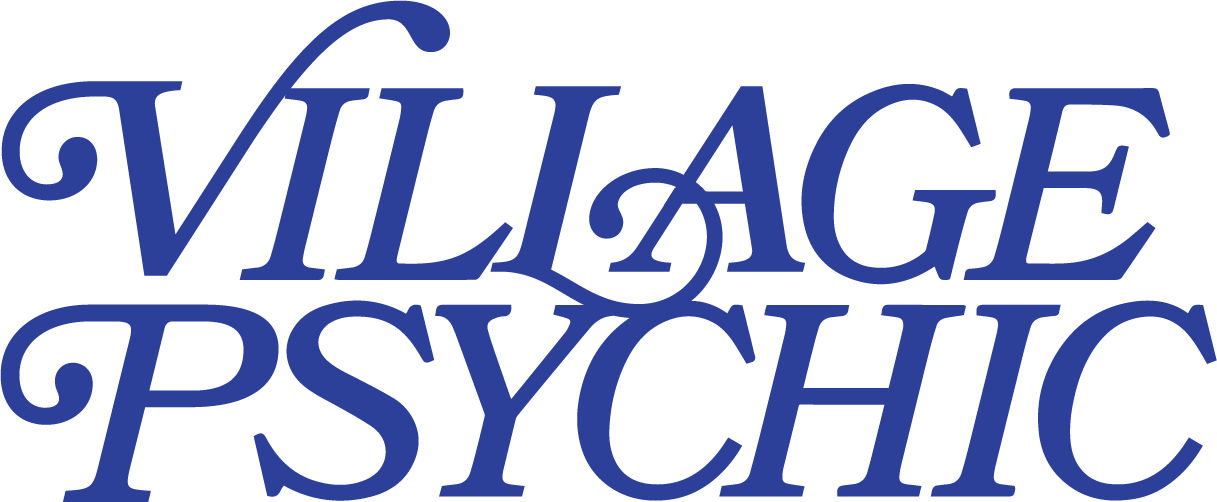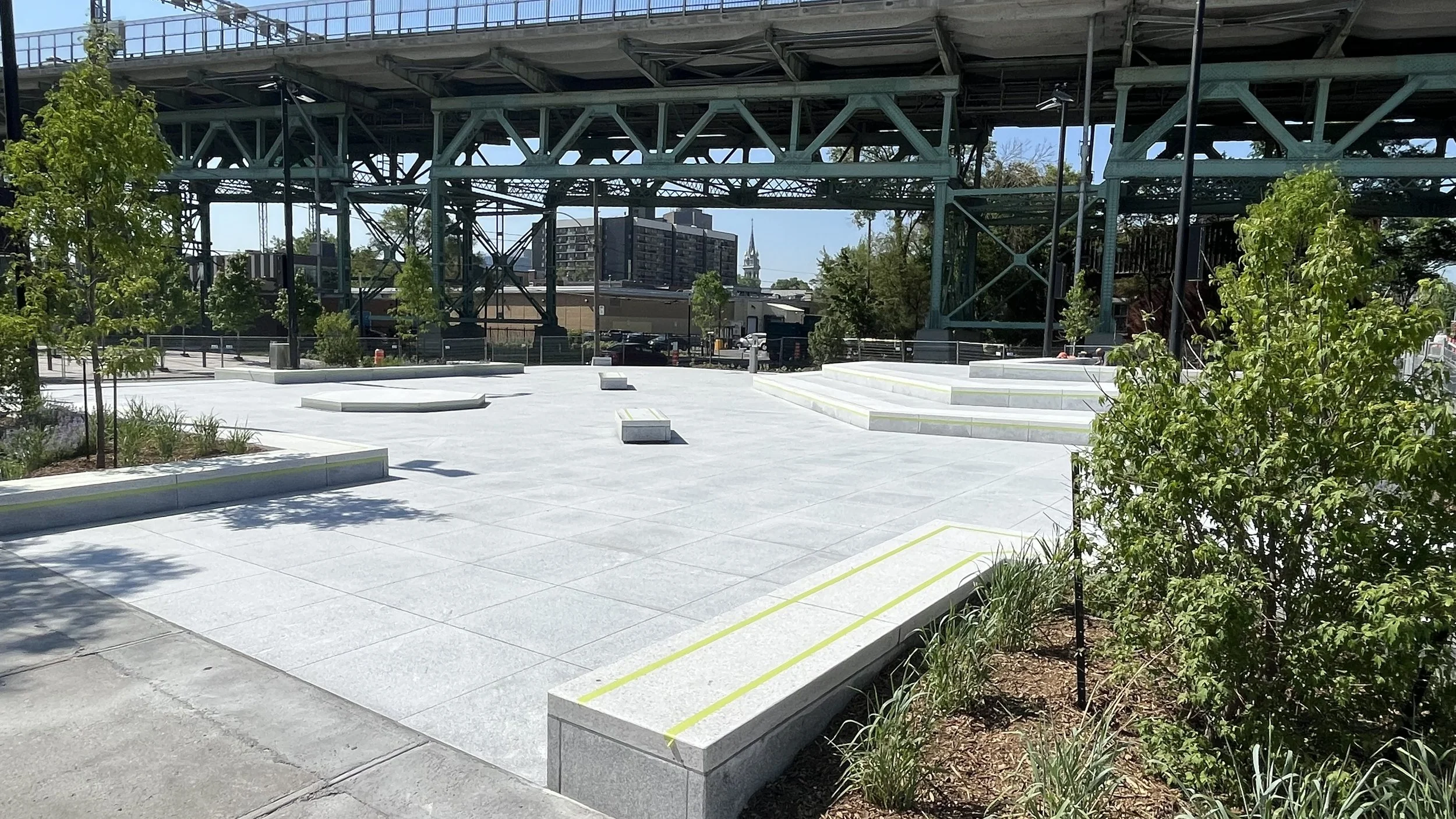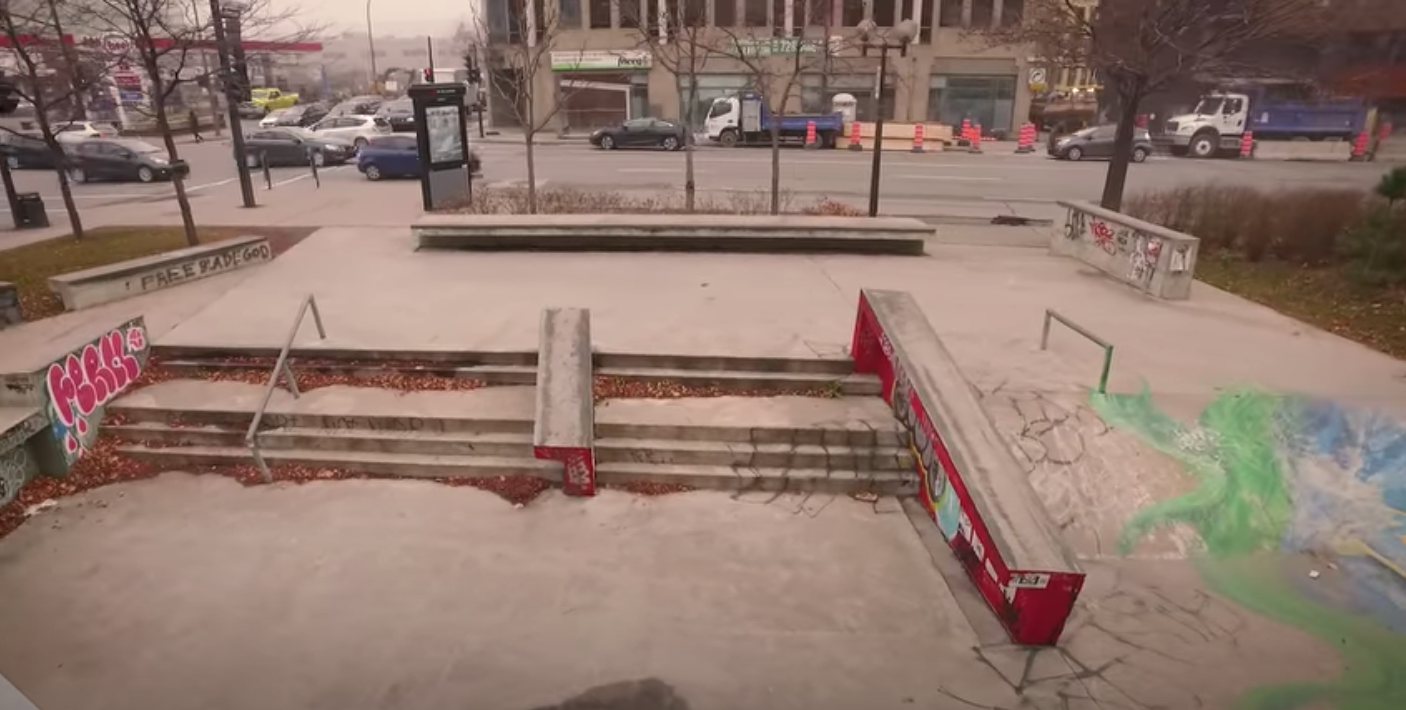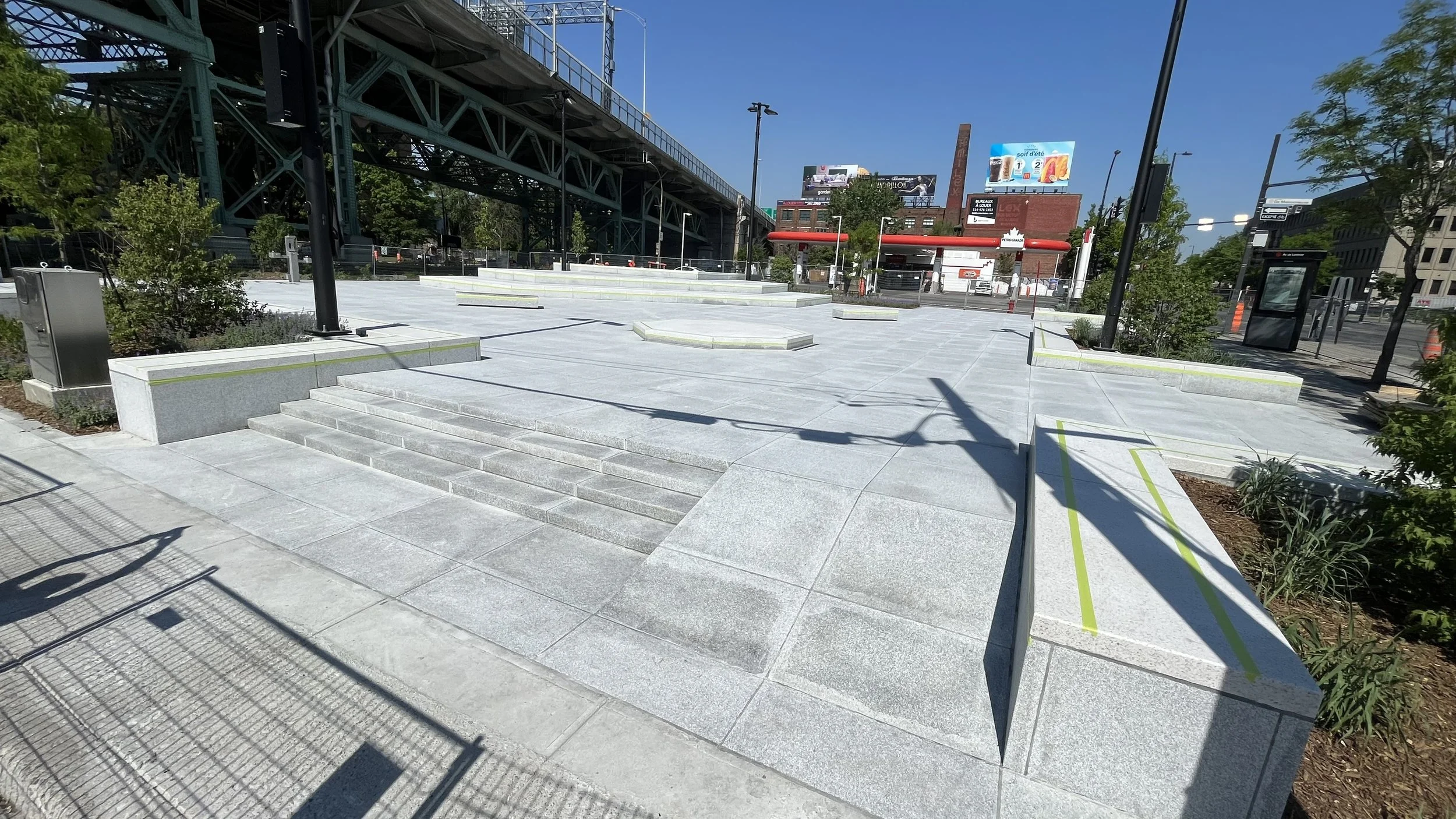The Best Plaza is in Montreal
Montreal Skate Plaza. All plaza photos by Charles Dechamps.
Village Psychic
We'll start by talking about this thing that you guys made. What do you call it? A skatepark? Is it a plaza? Is it a plaza style park?
David Boots
I'm happy that you brought this up, because words are important, and I feel that some of the terms that used to describe skateboard facilities are used very loosely. Our project is different from being a skateboard park or a skate plaza, because our project had to take into consideration many aspects that have to be thought about when you're designing something for the general public. For example, if you were building a skateboard plaza, you wouldn’t have to worry about how pedestrians will walk across the plaza. There are certain things that Charles and I, when we worked with the city, had to think about in terms of it being a public space rather than a skate plaza.
There's a skate plaza in Vancouver, which by some is considered the first in Canada. It's a skate plaza, it has a transition, rails, hubbas, and banks, whereas our plaza doesn't have anything but ledges and few steps. It's an urban design project that takes skateboarding into consideration. Our mayor Valérie Plante and the City of Montreal don’t consider it a skatepark or a skate plaza.
These two are the reason the plaza exists - Charles Dechamps and David Boots
VP
What were the steps to get working with the city on this?
Charles Dechamps
This all started as a new skatepark project because there was already a skatepark in the plaza’s current location, a really shitty one. It was horrible and basically unskateable since it was designed without the help of the skate community. Most of the obstacles were oddly sized, and they tried to cram too many things into too small of a space. So that needed to go. The first idea was to get that skatepark a more up to date design, with obstacles that reflect the skate community's desires.
That's when we had a committee of skaters that we had to meet up and talk about different types of skateparks, explaining that we could be doing something with a bunch of transition, or something more like the Vancouver skate plaza, which is a skatepark with a vibe of a plaza. We presented a bunch of different ideas, including one that was a granite plaza, something similar to Peace Park, where skating had been legalized with the help of Dave a few years before and people had responded really well. A lot the drug activity that had been happening there went away and the park kind of had a new vibe to it.
VP
Did that come up when you were starting to talk to people in the surrounding neighborhood?
DB
I wanted to put a plaza where that poorly designed skateboard park was. To do that, I applied what I had learned through the legalizing of skateboarding at Peace Park, that the way to get the city on board is to do events in the space. So in 2017, I organized an event called ‘Best Tricks Worst Obstacles’, (Meilleur Trucs Pire Obstacles). That was done under the umbrella of the Montreal Skateboard Association (Association Skateboard Montreal), which is a nonprofit organization I work with, because the city will only work with non-profit organizations. It was a great success because it showed the city that we wanted to appropriate the space, but that we weren’t using it because it was poorly designed.
When you get grants, like we did for that event, you have to write a final report. You have to say what went well, what didn't go well, and then you have to make recommendations. It was in that recommendation where I asked for money to renovate the park and also to give us financing so that we could animate the park on a regular basis, as we were already doing at Peace Park. That's what got the ball rolling, and then they came back four years later and said that we ’d have a budget. It was about $1.5 - $1.7 million, with taxes. My mission was totally to put a plaza there from day one. We did have to have a meeting with a committee, and were aiming to sell the city on letting us build an all granite plaza. Right away that didn't make any sense to them, so we explained to them that we wanted to build a plaza, a place that was multifunctional that can be used during the day when skateboarders aren't there, because generally skateboarders aren't there in the morning. People can use it for their lunch, and then we can skateboard in the afternoon, as we've been doing for years at Peace Park.
VP
Did that seem to cement the deal then once people understood that there could be other uses for the space?
DB
There were some other aspects that resonated, like using granite. It looks nice. Graffiti artists don't usually graffiti on granite, I don't know why – sometimes there will be tags, but at a normal skatepark that's made out of cement, people just go and spray paint the whole thing. For some reason, City Hall was all granite, Peace Park is all granite, and it's really rare that people tag or paint there.
That's how the project got started. Once we got the money and we were able to convince the city, we had designed the plaza but we quickly saw that we were going over budget. At that point it was kind of a gamble, we had to roll the dice. If we went over budget and didn’t get the funds, the whole project could have been canceled. They couldn’t just build the same design out of cement, because the engineering firm had already started the blueprints for granite. So, what I did was write a letter of support that I sent out to the whole skateboard community in Montreal. All the skateboard companies and all the skateboard stores, we had about 30 people sign it. With the support of the skateboard industry in the community, we were able to convince the city to give us an extra million, which brought the project’s budget to $2.7 million.
CD
When meeting with the committee, we talked a lot about the different aspects of the possibility of having an urban granite space; a multifunctional plaza that not only would attract street skateboarders, but would also attract non skaters users that would like to eat lunch, relax or just want a little break from the fast pace of the city, It would also give the opportunity to do skate events, little music shows, and other gatherings for the communities that use the space.
We also talked about the other options like having a classic concrete skatepark, but that idea was quickly discarded since the space was too small to fill with ramps and quarterpipes. It would have given a similar vibe to the previous skatepark design, with too many obstacles and not enough space to contain them.
In general, there seemed to be a lot more enthusiasm around a simple granite plaza layout. More space to circulate and skate around, more space for more users to skate at the same time, more direct lines to avoid collision between users, and it gives the space a more inviting vibe for the people that just want to walk through or enjoy the space.
With all that said, in the meetings, the users were pretty clear with their demands and the city officials were also very happy with the way everybody agreed on the idea of a granite plaza.
VP
What is the surrounding neighborhood like?
CD
The neighborhood is nice, but then there’s the street culture. It’s close to an area where there’s a lot of drug use.
DB
I don't know how familiar you are with Peace Park, it could be maybe a good topic for discussion for another day. Just to give some context, Peace Park is in the historical red-light district on Saint-Laurent Boulevard by Saint-Catherine street. The Montreal Plaza is way down Saint-Catherine Street on avenue De Lorimier. Between the two plazas is Berri Metro or Berri Square, also known as Place Émilie-Gamelin. Berri is where most of the social urban problems in the city congregate, such as the homelessness, people with addiction problems, mental health issues, and sex workers. Peace Park and the Montreal Plaza are at the extremities from Berri, the epicenter of all that.
VP
What was the community’s take on the previous skatepark there?
CD
Nobody liked it. Skaters didn’t like it because you couldn't do anything. There were rails with no run up, there was a sewer cap in the bank and a bunch of other nonsense. People weren’t skating it, so it started to get taken over by people who went there to drink and left broken bottles everywhere. It wasn’t very nice looking, and it wasn’t really a safe space for people to skate and walk around.
DB
The new design animates the space, and I just heard from two elderly women that said they feel safer now walking through the plaza.
VP
What was it like explaining that skaters really just want a good ledge, rather than quarterpipes, rails, or anything else?
CD
It came with trust, but at first they didn't really understand.
We have to understand that not everybody skates the same way and at the same level, so it wasn't everybody that wanted just nice granite ledges. Since a lot of new skateparks with ramps and quarterpipes are popping up around the city, everybody seemed to understand the idea that a granite plaza with ledges would be a good complement of the other designs out there.
DB
There was a meeting I attended at which I was able to take in all the information about what the neighborhood wanted. They wanted trees, they wanted birds, they wanted no sound, all these things. We responded to most of those needs, and then when we were building the plaza, there really wasn't much resistance from the city because we explained that it was a multifunctional space.
Another big thing that helped was that the architect for the city, Vincent Lemay, who worked on the project with us used to be a skateboarder, so he got it. Also, because I had already legalized skateboarding at Peace Park, we were able to speak to something they already understood, that we wanted something like Peace Park, but with lower ledges and that's more skateboard friendly.
CD
There's still people doing drugs in the area. But it’s just different now, when we go skate there, if I say I want to skate the ledge, people will get out of the way, or they’ll tell their friend to move. It's cool how we can coexist pretty well there. A lot of new people come, and they’re there just eating lunch. It's a lot cleaner than it used to be, and police don’t just show up to try to see if you're smoking a joint or drinking a beer. It's just a public space, it's being used by skaters still and the general public loves it as well.
VP
How did you get to a place where you have the reputation as people who can design skateparks?
CD
At first I didn't have any background other than being a skater and wanting to do it. I was studying architecture, getting my degrees to be able to design houses and buildings, but then I got more into it (skatepark design) because pretty much all the skateparks in Quebec were in really bad shape; pre-made concrete SOLO ramps on asphalt with the same layout/obstacles over and over in all the cities. No work had been put into skateparks in Quebec for many years. I knew we desperately needed new skateparks and I saw the opportunity to help and work on the future skatepark projects.
I first started to work on skateparks in the province of Quebec with a landscape architect, I got to learn a few things with him and eventually, a few friends and I started working together to get to talk to city officials in Montreal to get involved in the newer and bigger projects in Montreal.
Finally, I had a talk with the city of Plateau, and they kind of guided me into how it all works. To work together, the have to hire specific companies, and they need to work with a non-profit organization, you need to form one in order to discuss what’s possible. That way, the non-profit can offer a service that actually be used to help build things. We got a group of people that were really into it and thought it would be a good time for change. It was a long process, because there wasn’t not much interest or money going into it at first. It was just getting people together, trying to reach out to the right people to build up committees and getting more people involved – that's usually how it goes.
So eventually, that group got involved in the design of the Van Horne park, which took a lot of years and a lot of ups and downs. The one we were looking at before, Orange Park, the park under the bridge.
A lot of people got involved, and it got pretty hard to manage, this city wanted one thing, and others would want something else. P45 got involved to help with the design, they had things they wanted as well. It was a big learning curve, and a few things did go wrong in the process, but in the end it was pretty successful. I knew that it ended up being a success for the area – it used to be pretty dead, it’s near train tracks and the local businesses weren't doing very well. Once the park got put in, there were so many people going over there, a lot of the businesses around started to have more people coming around just to hang out, even at night. There’s just been a new wave of excitement in the area. So after doing that park, our reputation started to be known by the other city Arrondissements, the boroughs, and it eventually led us to the borough of Ville-Marie for the Plaza.
DB
Part of legalizing skateboarding in Peace Park was working with one of my mentors, her name is Monique Savoie and she was the founder and CEO of the Society for Arts and Technology, which is right next to Peace Park. She explained to me that I needed to start a non-profit for skateboarding. When I started trying to take those steps, that's when I found out that someone had already started a skateboarding non-profit, which was the Montreal Skateboard Association. From there it was kind of a no brainer, I knew I had to join up with them. They were already building skateparks, they'd been doing an excellent job and they've been building skateparks not just in Montreal, but all over the regions around Montreal. I just try and concentrate on improving things in the Ville-Marie borough because there's a lot of moving parts to it. The players are always changing, and there's a lot of politics involved as well.
The skatepark that previously inhabited the space now occupied by the plaza. Grabbed from here.
VP
What is the perspective the city seems to have? What do they want to get out of it?
CD
I don't know, they usually build tennis courts and basketball courts. It's nothing exciting. What we do is to bring some exciting ideas to the city and build something new that people will like, something that gets the kids moving. When they heard that this plaza was something unique, all designed and taken care of by skaters, they started to see the excitement. People talked about it, and then everyone started to see it as a successful community project.
Skateboarding has been thriving lately, with it being in the Olympics and all these big contests and stuff. Part of it is surfing the whole wave of skateboarding’s popularity right now.
VP
What sort of spots were you guys thinking about when you were working on this?
DB
I set out to get a plaza built in our city, I just wanted a plaza, an all granite plaza with ledges that were the right height. Peace Park has high ledges, I wanted ledges that were low enough. Basically, just a manny pad and ledges, you know?
CD
I find the Peace Park ledges to be pretty high for everyday skating. The ground is pretty good, but it's still not perfect. We don't have a lot of good ground with good ledges in the city. It's all kind of crusty with cracks, or there's granite ledges that don't grind. There's always something. The space we had to work with was so small, the design kind of developed itself, because we wanted to utilize the longest line in the space, which is the diagonal. There's also this big vent for the Metro that we couldn't touch or move and we had to plan around that as well.
DB
Figuring out what the usable space on the lot would be was like pulling teeth the whole time. We weren't allowed to touch the Metro grate, we weren't allowed to touch the trees, we weren't allowed to do anything. Eventually, I said, “Look, if you don't remove these trees, it's like you're leaving us with a poorly designed major obstacle from the previous skatepark.” It was a really long process to convince them to let us basically get rid of everything except the Metro grate. The main points that we really wanted to make sure we covered was ensuring a major flow line. The type of granite was important as well, I did a lot of research to make sure that we had a really dense, fine grain granite so that we knew that it was going to grind and would last forever. Some granite has larger grains and it’ll chip more easily.
We have Bethel White granite on the edges, which is very close to the same granite at Love Park. From the experts that I spoke with, because I couldn’t go in person to check, Love Park was built from Mount Airy granite, which comes from North Carolina. Bethel White is almost identical, but it comes from Vermont, which is much closer to here, so it was less expensive for us. The ground is made from Stanstead granite, which comes from our province. We didn't want it to be too polished, we used a honed finish, which is basically a saw cut. It’s smooth, so you can still pop but it’s not slippery.
CD
That's the thing with granite, it can be super smooth and super good to skate. Not only does it grind and slide very well, it can give you a nice snap when you pop, and also provide a good surface to land on since it gets quite grippy. It can help catch your balance when you don't land perfectly. It is also very flat, so I find it better to skate than concrete.
Concrete is nice because you can form into quarter pipes, but if it gets polished and it gets dusty, it gets too slippery. And if you don't polish it, it gets super rough quickly. It's hard to find the perfect balance with concrete finish.
DB
One of the special features of our plaza is that the tiles that we’re sliding and grinding are four inches thick, so our wheels never get caught in the edge. Charles made sure that he made it four inches everywhere.
VP
Did you guys do an opening event?
DB
We did, and the mayor showed up. The city usually has a detailed plan to follow when she shows up at an event. She shows up and then she gets whisked around, so I thought I was just going to meet her briefly and give a speech. Once the mayor and her people got there, they decided to do it organically, and I had to basically chaperone her for an hour, I felt like I was on a first date with everybody watching. I knew what I wanted to say to her, and I felt comfortable speaking, but I just wasn't mentally prepared for that scenario. It was kind of weird, because people were trying to talk to her while I was trying to maintain a conversation with her, but we did end up having a good conversation. The most important part was letting her know where we want to continue to go in the future with skateboarding in the city.
I basically explained to her that this project confirms that skateboarding adds a positive contribution to the Montreal community, and that it recognizes skateboarding not just as a sport, but as an urban culture.
Once skateboarding is recognized as a culture, then all of a sudden you can take it into consideration with the arts, and everything else that goes into skateboarding, such as artwork, filming, photography, and videos. One of the problems we have when we want to do events is having to go to the Department for Sports and Recreation. Their budget is much smaller than the Arts and Culture Department, and skateboarding needs balance between being a sport and a culture. Things take time, but this was a good first step to helping the city understand that skateboarding is a culture so that we can get money to maybe do a skateboard festival or some other event, or something that’s not just presenting skateboarding as a sport. I also explained to her that we want to be able to work with the city to incorporate skateboarding to future urban planning designs, similar to what they’ve done in Copenhagen.







